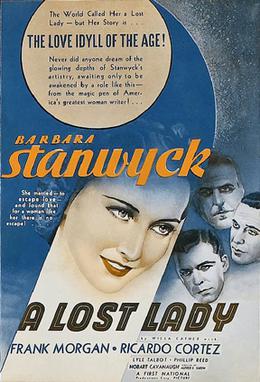Related Research Articles

Willa Sibert Cather was an American writer known for her novels of life on the Great Plains, including O Pioneers!, The Song of the Lark, and My Ántonia. In 1923, she was awarded the Pulitzer Prize for One of Ours, a novel set during World War I.

Alexander's Bridge is the first novel by American author Willa Cather. First published in 1912, it was re-released with an author's preface in 1922. It also ran as a serial in McClure's, giving Cather some free time from her work for that magazine.
"The Sculptor's Funeral" is a short story by Willa Cather. It was first published in McClure's in January 1905.

One of Ours is a 1922 novel by Willa Cather that won the 1923 Pulitzer Prize for the Novel. It tells the story of the life of Claude Wheeler, a Nebraska native in the first decades of the 20th century. The son of a successful farmer and an intensely pious mother, he is guaranteed a comfortable livelihood. Nevertheless, Wheeler views himself as a victim of his father's success and his own inexplicable malaise.
The Ballad of Baby Doe is an opera by the American composer Douglas Moore that uses an English-language libretto by John Latouche. It is Moore's most famous opera and one of the few American operas to be in the standard repertory. Especially famous are the title heroine's five arias: "Letter Aria," "Willow Song," "I Knew it Was Wrong", "Gold is a Fine Thing", and "Always Through the Changing." Horace Tabor's "Warm as the Autumn Light" is also frequently heard. Distinguished sopranos who have portrayed Baby Doe include Beverly Sills, Ruth Welting, Karan Armstrong, Faith Esham, and Elizabeth Futral.
"Paul's Case" is a short story by Willa Cather. It was first published in McClure's Magazine in 1905 under the title "Paul's Case: A Study in Temperament", which was later shortened. It also appeared in a collection of Cather's stories, The Troll Garden (1905). For many years "Paul's Case" was the only one of her stories that Cather allowed to be anthologized.

Lucy Gayheart is Willa Cather's eleventh novel. It was published in 1935. The novel revolves round the eponymous character, Lucy Gayheart, a young girl from the fictional town of Haverford, Nebraska, located near the Platte River.
"Nanette: An Aside" is a short story by Willa Cather. It was first published in Courier on 31 July 1897 and one month later in Home Monthly.
"A Gold Slipper" is a short story by Willa Cather. It was first published in Harper's in January 1917.
Ardessa is a short story by Willa Cather. It was first published in Century in May 1918.
The Bohemian Girl is a short story by Willa Cather. It was written when Cather was living in Cherry Valley, New York, with Isabelle McClung whilst Alexander's Bridge was being serialised in McClure's. It was first published in McClure's in August 1912.
On the Gulls' Road is a short story by Willa Cather. It was first published in McClure's in December 1908.
A Singer's Romance is a short story by Willa Cather. It was first published in Cosmopolitan in July 1900.
Eleanor's House is a short story by Willa Cather. It was first published in McClure's in October 1907.
"The Profile" is a short story by Willa Cather. It was first published in McClure's in June 1907.
The Namesake is a short story by Willa Cather. It was first published in McClure's in March 1907.

My Mortal Enemy is the eighth novel by American author Willa Cather. It was first published in 1926.

A Lost Lady is a 1934 American drama film directed by Alfred E. Green and starring Barbara Stanwyck, Frank Morgan and Ricardo Cortez. It is based on the 1923 novel A Lost Lady by Willa Cather, with a screenplay by Gene Markey and Kathryn Scola. Warner Bros. had produced a 1924 silent film based on the story, starring Irene Rich.

The Life of Mary Baker G. Eddy and the History of Christian Science (1909) is a highly critical account of the life of Mary Baker Eddy, the founder of Christian Science, and the early history of the Christian Science church in 19th-century New England. It was published as a book in November 1909 in New York by Doubleday, Page & Company. The original byline was that of a journalist, Georgine Milmine, but a 1993 printing of the book declared that novelist Willa Cather was the principal author; however, this assessment has been questioned by more recent scholarship which again identifies Milmine as the primary author, although Cather and others did significant editing. Cather herself usually wrote that she did nothing more than standard copy-editing, but sometimes that she was the primary author.
Georgine Milmine Welles Adams best known as Georgine Milmine, was a Canadian-American journalist most known for writing about Mary Baker Eddy, the founder of Christian Science. Milmine, along with Willa Cather and others, worked on 14 investigative articles about Eddy that were published by McClure's in 1907–1908. One of the only major investigative works on Eddy to be published in her lifetime, besides Sibyl Wilbur's Human Life articles, the articles were instigated by Milmine: S. S. McClure purchased her freelance research before assigning a group of reporters to verify, expand and write it up.
References
- ↑ Edward Killoran Brown, Willa Cather, a Critical Biography, Random House, 1953, p. 210
- ↑ Woodress, James Leslie (1989). Willa Cather: A Literary Life. University of Nebraska Press. p. 278.
- ↑ Stout, Janis P. (2000-12-29). Willa Cather: The Writer and Her World. University of Virginia Press. pp. 130–131. ISBN 978-0-8139-3360-3. Archived from the original on 2024-08-18. Retrieved 2016-11-07.